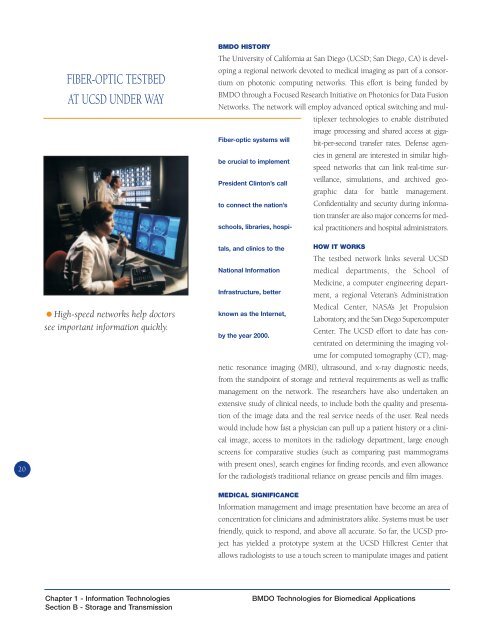bmdo technologies for biomedical applications - MDA Technology
bmdo technologies for biomedical applications - MDA Technology
bmdo technologies for biomedical applications - MDA Technology
You also want an ePaper? Increase the reach of your titles
YUMPU automatically turns print PDFs into web optimized ePapers that Google loves.
FIBER-OPTIC TESTBEDAT UCSD UNDER WAY20• High-speed networks help doctorssee important in<strong>for</strong>mation quickly.BMDO HISTORYThe University of Cali<strong>for</strong>nia at San Diego (UCSD; San Diego, CA) is developinga regional network devoted to medical imaging as part of a consortiumon photonic computing networks. This ef<strong>for</strong>t is being funded byBMDO through a Focused Research Initiative on Photonics <strong>for</strong> Data FusionNetworks. The network will employ advanced optical switching and multiplexer<strong>technologies</strong> to enable distributedimage processing and shared access at gigabit-per-secondtransfer rates. Defense agen-Fiber-optic systems willcies in general are interested in similar highspeednetworks that can link real-time sur-be crucial to implementveillance, simulations, and archived geographicdata <strong>for</strong> battle management.President Clinton’s callto connect the nation’s Confidentiality and security during in<strong>for</strong>mationtransfer are also major concerns <strong>for</strong> medicalpractitioners and hospital schools, libraries, hospi-administrators.tals, and clinics to the HOW IT WORKSThe testbed network links several UCSDNational In<strong>for</strong>mation medical departments, the School ofMedicine, a computer engineering department,a regional Veteran’s AdministrationInfrastructure, betterMedical Center, NASA’s Jet Propulsionknown as the Internet,Laboratory, and the San Diego SupercomputerCenter. The UCSD ef<strong>for</strong>t to date has concentratedon determining the imaging vol-by the year 2000.ume <strong>for</strong> computed tomography (CT), magneticresonance imaging (MRI), ultrasound, and x-ray diagnostic needs,from the standpoint of storage and retrieval requirements as well as trafficmanagement on the network. The researchers have also undertaken anextensive study of clinical needs, to include both the quality and presentationof the image data and the real service needs of the user. Real needswould include how fast a physician can pull up a patient history or a clinicalimage, access to monitors in the radiology department, large enoughscreens <strong>for</strong> comparative studies (such as comparing past mammogramswith present ones), search engines <strong>for</strong> finding records, and even allowance<strong>for</strong> the radiologist’s traditional reliance on grease pencils and film images.MEDICAL SIGNIFICANCEIn<strong>for</strong>mation management and image presentation have become an area ofconcentration <strong>for</strong> clinicians and administrators alike. Systems must be userfriendly, quick to respond, and above all accurate. So far, the UCSD projecthas yielded a prototype system at the UCSD Hillcrest Center thatallows radiologists to use a touch screen to manipulate images and patientChapter 1 - In<strong>for</strong>mation TechnologiesSection B - Storage and TransmissionBMDO Technologies <strong>for</strong> Biomedical Applications




